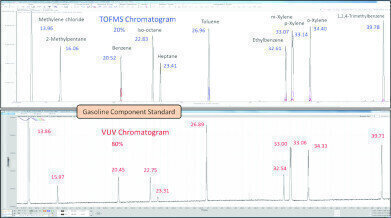-
 Figure 1. Comparison of GC-VUV-MS chromatograms collected with a post-GC column split
Figure 1. Comparison of GC-VUV-MS chromatograms collected with a post-GC column split
Analytical Instrumentation
Configuring Vacuum Ultraviolet Spectroscopy and Mass Spectrometry for Gas Chromatography for Hydrocarbon Analysis
Jun 07 2017
VUV Analytics, Inc. (Austin, TX) has continued its innovations in detailed hydrocarbon analysis (DHA) by combining GC-VUV with mass spectrometry (MS) to build a more extensive hydrocarbon library.
The result of this work will be robust analyte information that extends the capabilities of hydrocarbon compound verification via VUV spectral matching described in the APR / MAY edition (“GC-VUV Provides New Analytical Tool for DHA and Transformer Oil Compound Characterisation”). Vacuum ultraviolet spectroscopy (VUV) and mass spectrometry (MS) are highly complementary gas chromatography detectors, and the combination of technologies during this study will ensure a more seamless and routine DHA by GC-VUV.
This finished gasoline and gasoline-range detailed hydrocarbon analysis project used a Restek 100m x 0.25mm x 0.50µm Rtx-DHA GC column connected, post-GC column, to a microfluidic splitting device from SepSolve Analytical. This simple “Y” splitter had one transfer line of 5m x 0.10mm uncoated, deactivated fused silica tubing going to a Markes International Bench-TOF Select time-of-flight mass spectrometer (TOFMS) and another transfer line of 5m x 0.15mm uncoated, deactivated fused silica tubing connected to a VGA-100 gas chromatography detector such that mass spectra and absorbance spectra could be collected simultaneously. This straightforward setup was accomplished with off-the-shelf components that were easily installed. In total, it included one GC inlet and column, a Y splitter, two transfer lines, and two complementary, comprehensive spectral detectors.
The data generated has lent itself to easy interpretation given the similar retention times (with just a slight constant offset) for both TOFMS and VUV as shown in Figure 1. This same post-GC column split approach can be extended to other GC detectors (e.g., FID, SCD, TCD, etc.). Chromatographic consistency was achieved through the use of a simple microfluidic 3-port splitting device and a split configuration of 20% GC effluent to the TOFMS and 80% to the VUV detector. This GC-VUV-MS work has demonstrated comprehensive compound identification capabilities despite the TOFMS requiring a vacuum outlet and the VUV utilising an atmospheric outlet.
GC-VUV offers advantages over GC-MS for routine hydrocarbon analysis including (1) the ability of VUV spectroscopy to differentiate coeluting isomeric compounds based on their absorbance spectra, (2) the use of VUV spectral information to provide compound class characterisation as described in ASTM Method D8071, Standard Test Method for Determination of Hydrocarbon Group Types and Select Hydrocarbon and Oxygenate Compounds in Automotive Spark-Ignition Engine Fuel Using Gas Chromatography with Vacuum Ultraviolet Absorption Spectroscopy Detection (GC-VUV), and (3) VUV spectroscopy’s capacity to provide more uniform response factors for unknown analyte quantification.
For more detailed information please visit our website at www.vuvanalytics.com, or contact us at info@vuvanalytics.com.
Digital Edition
PIN 25.1 Feb/March
March 2024
In This Edition Safety - The technology behind the ION Science Tiger XT - Safety with ammonia and LOHCs as hydrogen carriers Analytical Instrumentation - Discussion on new tribology te...
View all digital editions
Events
Apr 24 2024 Mumbai, India
Apr 24 2024 Jakarta, Indonesia
Apr 28 2024 Montreal, Quebec, Canada
Apr 30 2024 Birmingham, UK
May 03 2024 Seoul, South Korea

















